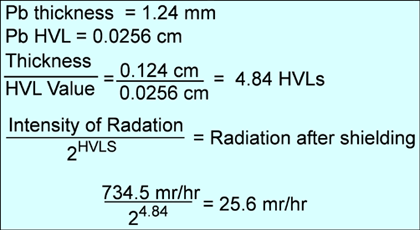- Thickness – the thicker the absorber the greater the shielding
- Density – the denser the absorber is the greater the shielding
- Hence the following formula shows the relationship between density (later referred to as ρ) of the material (gm/cm3) and thickness (later referred to as μ) of the material (cm) of the same material. Consider this concept as density thickness,
which is also referred to as ρ/μ

- In addition
- The Z number does not always directly relate to density
- Density changes when the same element is in a solid, liquid, or gaseous state
- Can you think of a good example?
- Is defined as the amount of or fraction of photons removed from a radiation field per cm of absorber(cm-1)
- The final answer is expressed as a constant % which is then multiplied by the amount of initial radiation being emitted
- Special comment - μ is the analog of the decay constant (λ) and we've get back to this in just a bit
- The ability for any material to absorb depends on
- Its thickness
- Its density (depends on it state)
- Energy gamma be absorbed
- Value is obtained by taken the linear attenuation coefficient and the density of the material
- Expressed as gm/cm2
- Linear attenuation (μ) varies depending on its state (gas, liquid, or water). The issue here is that the density will vary depending on its physical state. Therefore its density and thickness must be considered when it is being used as an attenuator as is what needs to be considered when using μ to calculate attenuation
- Mass attenuation (μ/ρ) only relates to the density of the absorber (not its thickness) therefore the physical state of the absorber is not a factor
- Consider the following physical states of water and note the μ, ρ, and μ/ρ relationships
- Shielding formulas uses linear attenuation coefficient
|
1 cm3 of water |
Water vapor |
Water liquid |
Water solid |
|
μ (cm-1) |
0.000128 |
0.214 |
0.196 |
|
ρ (gm/cm3) |
1.00598 |
1.0 |
0.917 |
|
μ/ρ (cm2/gm) |
0.214 |
0.214 |
0.214 |
- In general one would think that as the energy of gamma radiation increases the interaction with the absorber would have an exponential curve, however, while the curve general looks exponential there are to deviations that occur within it
- If the gamma energy is close to the binding energy of the L or K shell electron of the attenuator, photoelectric effect is less likely to occur and more attenuation will be needed. This is because photon interacts with electron’s binding energy
- The L shell interaction occurs at 20 keV and is referred to as the L-edge
- The K shell interaction occurs at 88 keV and is referred to as the K-edge
- Application to Nuclear Medicine? 133Xe requires more shielding that 99mTc because the 81 keV gamma is effected by the K-edge
- Consider the relationship – electrons per gram, similar to density, however, electrons replace cm
- The greater the number of electrons per gram the greater the probability that a gamma ray will interact in an absorber via Compton
- Just because an absorber is high in density does not necessary mean that it has a greater number of electrons
- Ag has a density of 10.5 with 2.751 x 1024 electrons
- Pb has a density of 11.35 with 2.701 x 1024 electrons
- Therefore Ag is a better attenuator that Pb
- Why doesn’t nuclear medicine use Ag instead of Pb for shielding?
- Interesting point – depleted uranium has greater density and electrons when compared to the above: density = 18.68 and electrons = 4.352 x 1024. When high levels of radiation require shielding, depleted uranium is considered

